
1982
ACT
INFORMATION
OFFICIAL
THE
UNDER
RELEASED
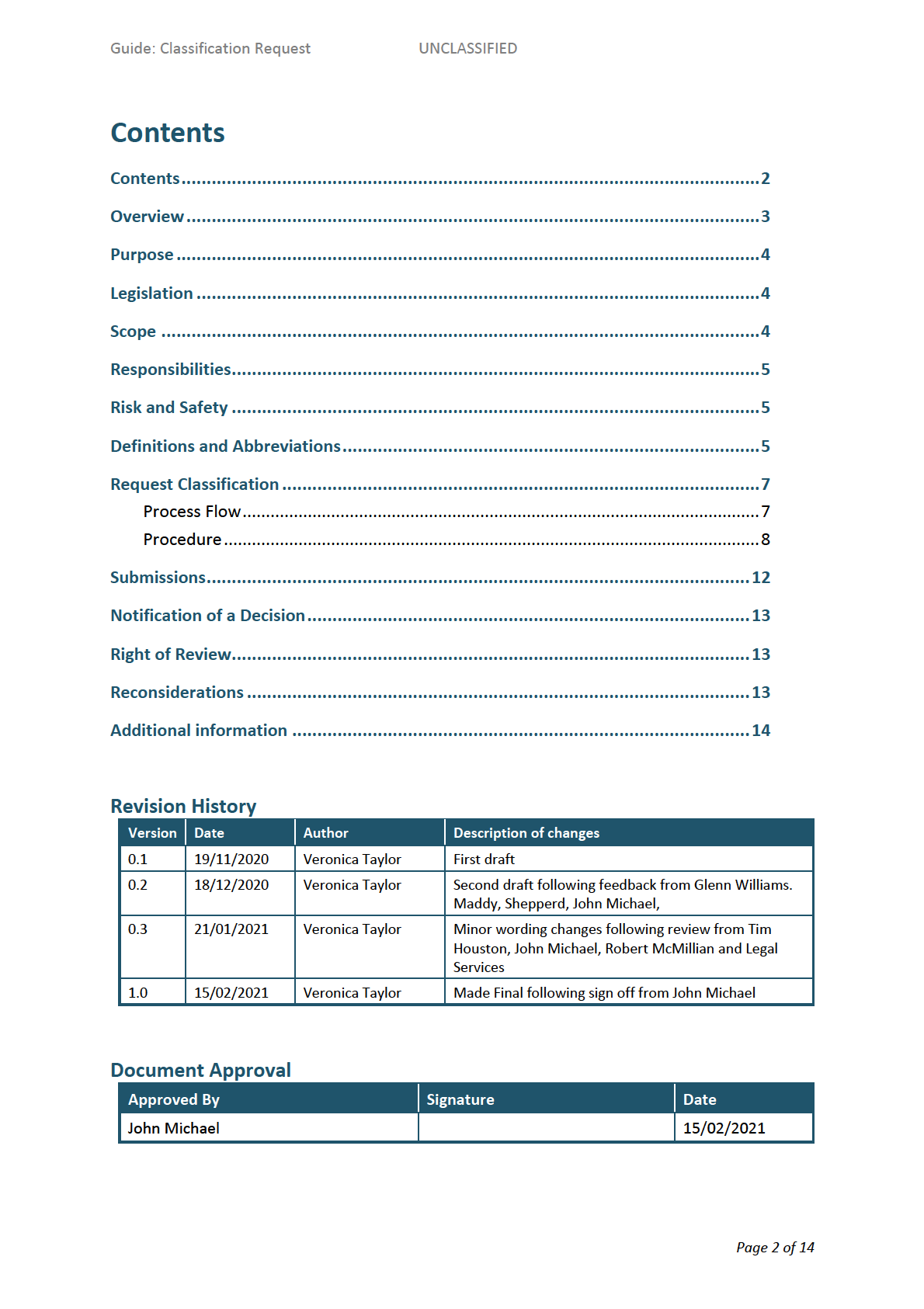
1982
ACT
INFORMATION
OFFICIAL
THE
UNDER
RELEASED
Guide: Classification Request
UNCLASSIFIED
Overview
The Films, Videos and Publications Classifications Act 1993 (FVPCA) provides the legal
framework for New Zealand's classification system. The purpose of the classification system
is to prevent harm to the New Zealand public by restricting the availability of publications
containing harmful material.
DIA, Police, Customs and NZ Courts can submit publications for classification and have an
automatic right of submission.
As part of the classification process, the Office of Film and Literature Classification (OFLC)
can receive submissions regarding the specific publications from interested parties.
1982
DIA can make submissions on a given publication and are notified by OFLC of publications in
which it can make a submission.
ACT
Once a decision is made, a copy of the decision is provided to the submitter and DIA and
added to a Public register maintained by OFLC.
Following a decision relevant parties have an opportunity to either:
• Request a review of the decision; or
• Apply for a re-classification after a period of time INFORMATION
CLASSIFICATION PROCESS
Submissions process
Standard process can
OFFICIAL
Court Requested
al ows 14 days
take 55 days
THE
Send to classification
office for Decision
s13(1)
Objectionable
Application
Restricted
-age
Censor may direct
Notification of and
Classification
Notification of a
-specified/class
Right of Review
UNDER
Publication
content be submited
right to make a
Decision
Classification
persons
s47
s13(3)
submission
-specified purpose
Censor may call in
Unrestricted
content
(can be used in time
critical events)
A time critical
decision can be
made within a day
RELEASED
Staff safety statement – this process involves viewing harmful material.
Page 3 of 14
Guide: Classification Request
UNCLASSIFIED
Purpose
The purpose of this SoP is to outlines the standard operating procedures for the Digital
Safety Team to complete the following tasks:
• Requesting/Submitting a Publication for Classification
• Making a Submission of a publication submitted by another party
• Receiving a classification decision
• Review/Challenging a decision
1982
This SoP will cover the process for both DVE and DCE.
ACT
Legislation
The classification process is covered in Part 3 of the FVPCA.
The definition of what a publication is described in Section 2 of the Act.
The definition of objectionable is covered in detail in section 3 of the Act.
A publication can be objectionable if it "describes, depicts, expresses, or otherwise deals
INFORMATION
with" matters such as sex, horror, crime, cruelty or violence and if its unrestricted availability
would be harmful to society.
DIA can submit a publication to the OFLC under section 13(1)(b) or the Chief Censor may
direct DIA officials to obtain copy of a specific publication and submit it for examination
under section 13(3). Other agencies that are able to sub
OFFICIAL mit a publication for classification
are Police and Customs.
THE
Court may also refer a dispute about whether a publication is objectionable to the
Classification Office under section 29(1), where the publication has not yet been considered
and a defendant disputes that a publication is objectionable.
An amendment bill is currently being considered in Parliament to make changes to this Act
UNDER
which includes the ability to request an interim assessment; making live streaming illegal;
and take down notices.
Scope
RELEASED
The scope of this process covers the full classification process. The process is triggered as
required when there is a need for a classification decision or DIA receives a notification of
the right to make a submission. The process is complete once a decision has been received.
OFLC have advised that the full classification process may take up to 55 days, which includes
the submission process.
OFLC may consider an urgent classification which involves the Chief Censor “calling in
content” and can lead to a decision within hours or days. The urgent process does not
include a submissions process.
Page 4 of 14

1982
ACT
INFORMATION
OFFICIAL
THE
UNDER
RELEASED
Guide: Classification Request
UNCLASSIFIED
OFLC
Office of Film & Literature Classification. Can also be referred to as the
Classification Office
FVPCA
Films, Videos and Publications Classifications Act 1993
DS
Digital Safety
DVE
Digital Violent Extremism
DCE
Digital Child Exploitation
Inspector of
A person appointed as an Inspector of Publications under s 103 FVCPA by
Publications
the secretary of DIA or a Constable of Police can also be deemed an
Inspector for the purposes of the FVCPA
1982
ACT
INFORMATION
OFFICIAL
THE
UNDER
RELEASED
Page 6 of 14
Guide: Classification Request
UNCLASSIFIED
Request Classification
1982
The request classification process will often run alongside other processes that relate to what, if any action can be taken if the content/publication is
harmful or viral.
ACT
Process Flow
Request Classification
tor of
Complete
Content
Deci sion Hui
Classification
Review
spec
Form
In
Publicatons
INFORMATION
Submit
Publication for
Classification
ent
No Classification
OFFICIAL
request
anagem
DS M
Request
THE
consideration for
an urgent
Classification
UNDER
FLC
Cal l In Urgent
Classification
O
Informal review with OFLC
Content
Deci sion
s
OFLC
Record
Store content
submission
content
and record
form
System
decision
RELEASED
Page 7 of 14

1982
ACT
INFORMATION
OFFICIAL
THE
UNDER
RELEASED

1982
ACT
INFORMATION
OFFICIAL
THE
UNDER
RELEASED

1982
ACT
INFORMATION
OFFICIAL
THE
UNDER
RELEASED
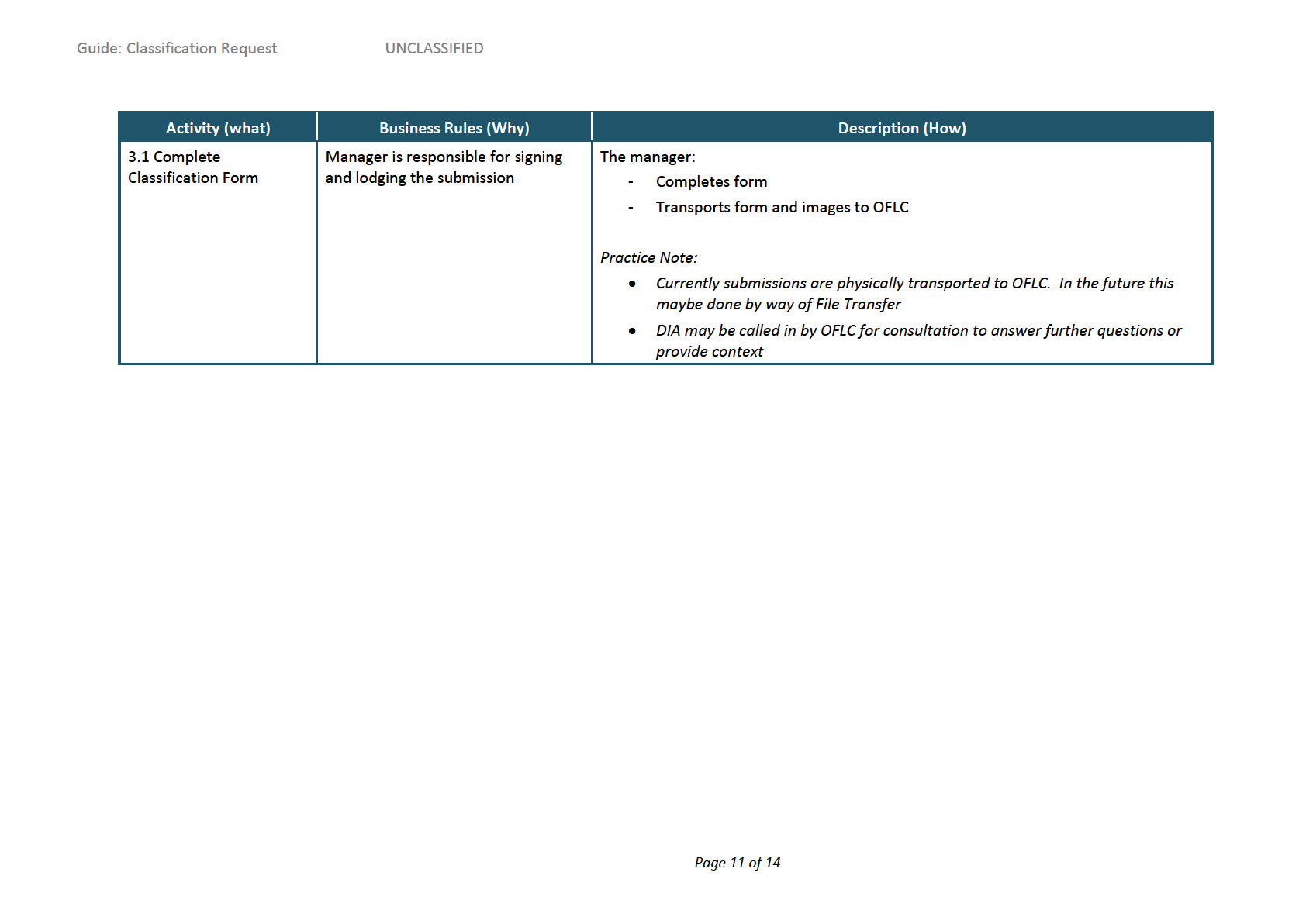
1982
ACT
INFORMATION
OFFICIAL
THE
UNDER
RELEASED
Guide: Classification Request
UNCLASSIFIED
Submissions
As part of the classification process, the Secretary may make a written submission of any
publication submitted to OFLC (s20 FVPCA).
DIA will be notified by OFLC when a classification is being considered. For DIA to decide to
make a submission, it will be necessary to ask for more information about the content or to
view the content.
Notification of a submission is currently managed by the Deputy Director.
1982
The Deputy Director or their delegate will review the notification and will request a viewing
of the content to decide whether to make a submission.
ACT
A submission must be made in writing and within the timeframe advised by OFLC
Making a Submission
INFORMATION
r
ty
u
Request content to
p
Decide to make
Receive Notification
consider a
Make a submission
e
a submission
D
irecto
submission
D
OFFICIAL
FLC
Classification
Provide content
THE
O
Decision
UNDER
RELEASED
Page 12 of 14
Guide: Classification Request
UNCLASSIFIED
Notification of a Decision
When OFLC have made a decision on a publication, they must notify the submitter and will
advise DIA.
All Decisions are currently sent through to the Deputy Director.
For Decisions regarding:
• DCE - DIA will obtain copies of the content and will link the content and the decision
in the DCE National image database.
1982
• CVE- Save documents into the OFLC Decisions folder in Cohesion within document
sets by Year
ACT
Summary of Decisions are also added to the Decision Register maintained by OFLC. These
can be found
https://register.classificationoffice.govt.nz/Pages/Screens/DDA/WarningPage.aspx
Right of Review
The owner, maker, publisher, distributor or whoever submitted the publication for
INFORMATION
classification has an automatic right of appeal on Classification Office decisions and can
apply for a review by the Film and Literature Board of Review. The application period is
limited to 30 working days from the date on which the decision was registered.
The Film and Literature Board of Review is administered by DIA. Information about this
process can be found https://www.dia.govt.nz/diawebsite.nsf/wpg URL/Agency-Film-and-
OFFICIAL
Literature-Board-of-Review-Index?OpenDocument
THE
Reconsiderations
A person charged with an offence can request that a classification decision be reconsidered
after one year. Classification Office or Board of Review decisions are regarded as conclusive
UNDER
evidence.
After a year has elapsed, a court, at the request of a person charged with an offence under
the Classification Act, can refer a decision to the Classification Office for reconsideration, or
to the Film and Literature Board of Review where it is a decision of the Board's.
RELEASED
Other parties involved (the owner, maker, publisher or authorised distributor) can submit a
publication for reconsideration after three or more years. More information can be found
on the OFLC website; https://www.classificationoffice.govt.nz/
Page 13 of 14
Guide: Classification Request
UNCLASSIFIED
Additional information
The following documents provide additional information:
• https://www.classificationoffice.govt.nz/officials/information-for-internal-affairs-
officials/
• The classification submission form can also be found at the above link
• DS Wellbeing policy (once completed)
• Classification Office Decision Register
https://register.classificationoffice.govt.nz/Pages/Screens/DDA/WarningPage.aspx
1982
ACT
INFORMATION
OFFICIAL
THE
UNDER
RELEASED
Page 14 of 14

Document 3
1982
ACT
Standard Operating
Procedu
INFORMATION
re:
Managing Content
OFFICIAL
THE
Translation
Digital Safety
UNDER
RELEASED
Cohesion reference:
https://dia.cohesion.net.nz/Sites/RGL/DSAF/DV/_layouts/15/WopiFrame.aspx?sourcedoc={8D229DD6-48B8-
4542-9F26-DBB85956DA39}&file=SoP%20Manage%20Content%20Translation%20DRAFT.docx&action=default
Page 1 of 11
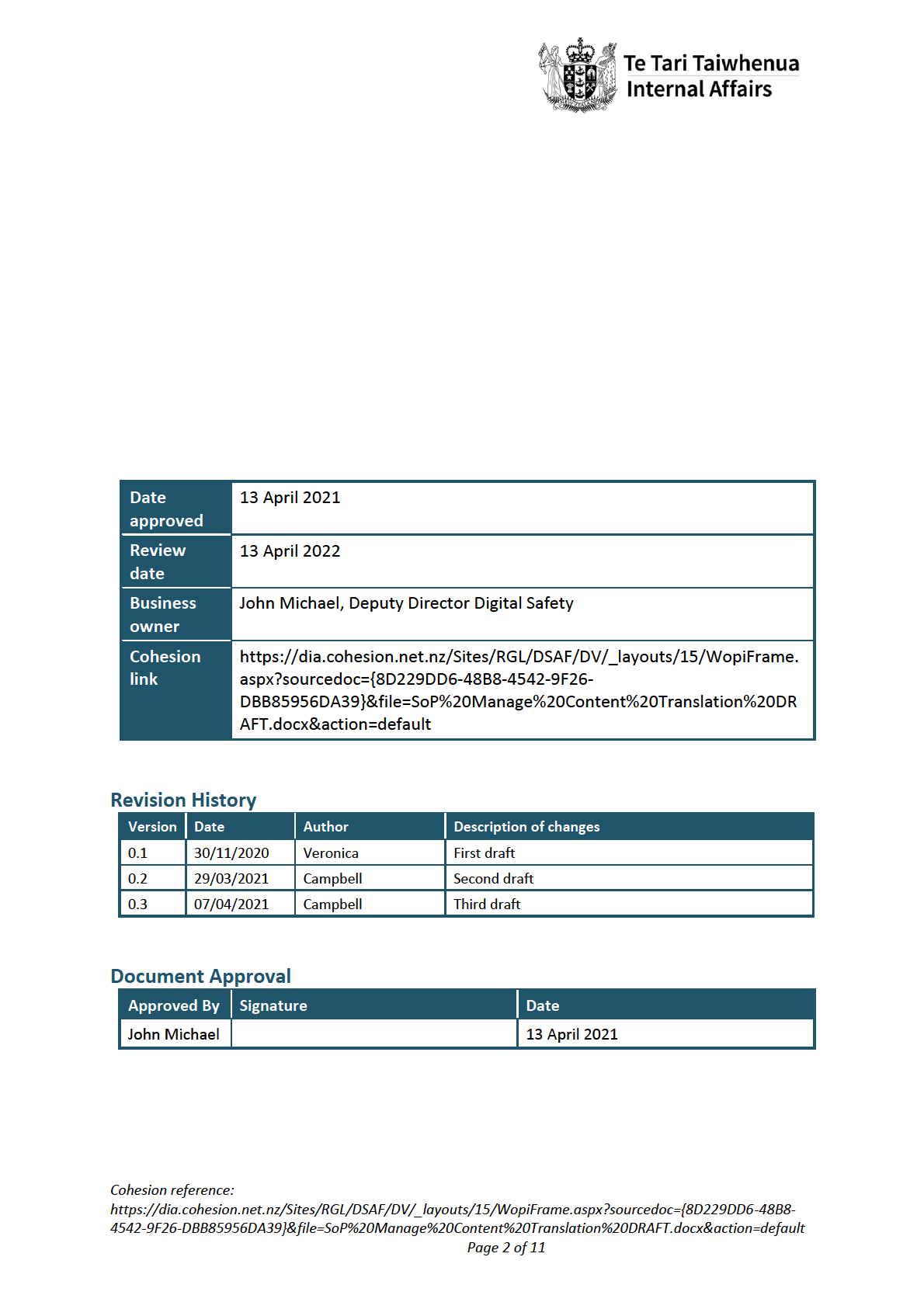
1982
ACT
INFORMATION
OFFICIAL
THE
UNDER
RELEASED
SoP: Managing Content Translation
UNCLASSIFIED
Contents
1982
Contents ........................................................................................................................... 3
ACT
Overview .......................................................................................................................... 4
Purpose ............................................................................................................................. 4
Legislation ......................................................................................................................... 4
Scope ................................................................................................................................ 5
Responsibilities ................................................................................................................. 5
INFORMATION
Risk and Safety .................................................................................................................. 5
TS Support Request Template …………………………………………………………………………………………. 6
Translating Content - Process Flow .................................................................................... 7
OFFICIAL
Translating content - Procedure ......................................................................................... 8
Appendix A - Translation Services Fee Schedule ............................................................... 11
THE
UNDER
RELEASED
Page 3 of 11
SoP: Managing Content Translation
UNCLASSIFIED
Overview
1982
From time to time content may include non-English language which may require a translation to provide a full understanding of the content and its
intent.
ACT
Translation Services is a business group within DIA that provides translation services across DIA, and other government agencies, translating material
from/to languages other than English. Digital Safety (DS) can use TS to have potentially harmful content translated on a case by case basis.
A pool of suitable translators within TS will be approved to work on content referred by DS.
Not all language will require formal translation. This SOP will cover when to get a formal translation.
This process potentially involves viewing harmful material. DIA has obligations to provide a safe environment for its safe and contactors and our
wellness policy addresses these issues.
INFORMATION
Purpose
The SOP provides guidance on steps to be taken where non-English language translations may be needed of content to aid investigations,
OFFICIAL
classifications and prosecution Legislation
The following legislation should be considered when managing translating content;
THE
• Films, Videos, Publications and Classifications Act 1993 Films, Videos, Publications and Classifications Act 1993 sets out the rules arounds the
definition is of objectionable publication.
• Section 13(4) and (5) affords certain persons protection for viewing objectionable content if they are acting in an official capacity
UNDER
• Privacy Act 2020 has 13 privacy principles that govern how you should collect, handle and use personal information.
RELEASED
Page 4 of 11
SoP: Managing Content Translation
UNCLASSIFIED
Scope
1982
This SOP covers:
• How to translate content
ACT
• When to get a formal translation
• The process to gain a formal translation
Translations will be required on an ad hoc basis depending on the content and what outcome is required.
Responsibilities
INFORMATION
DS management will need to approve any request for formal translation support, as this will incur a cost. Indicative fee schedule for TS support
attached at Annex A
Some members of the DS Team can provide a working interpretation of some languages. A spreadsheet of DS staff with non-English language skills is
located at; https://dia.cohesion.net.nz/ds-staff-language-skills
OFFICIAL
Manager DVE is responsible for managing the list of languages that can be covered within the DS Group.
Manager DVE is responsible for approving translation requests to TS.
THE
TS is responsible for updating and maintaining the list of cleared and specialist translators found at; https://dia.cohesion.net.nz/TS-cleared and
specialist translators
UNDER
Risk and Safety
The DS Wellbeing Policy should be read in conjunction with this SoP.
RELEASED
Page 5 of 11
SoP: Managing Content Translation
UNCLASSIFIED
Sharing harmful content with anyone must always involve consideration whether it is necessary to share and what action can be taken to reduce the
impact of the content on others.
1982
Before sharing content, staff will need to consider:
ACT
• Has the content already been deemed objectionable and therefore illegal?
• Is all the content required for the translation?
• Will the language itself be enough to support the translation?
• Can the content be summarised rather than shared in its raw and more harmful form?
• Can any harmful elements be hidden? E.g. blur images or only share audio rather than the image.
The Manager DVE or delegate responsible for TS relationship will meet with Translation Services Manager every 3-6 months to review process and
debrief any translations that have occurred within the period.
INFORMATION
TS Support Request Template
The Template to request translation support from TS is located at: Translation Services Request for Support
OFFICIAL
THE
UNDER
RELEASED
Page 6 of 11
SoP: Managing Content Translation
UNCLASSIFIED
Translating Content - Process Flow
1982
This process flow shows the process to translate content.
Translating Content
ACT
Make a
Is a formal
er
Confirm Basic
request for
Non English Content
Identify Language
Yes
translation
Yes
b
Translation
Translation
required
Services
em
No
No INFORMATION
S Staff m
Stop
Stop
D
OFFICIAL
ager
THE
an
Approve Cost
S M
D
UNDER
n
s
Translate
slatio
rvice
Content
Se
Tran
RELEASED
Page 7 of 11
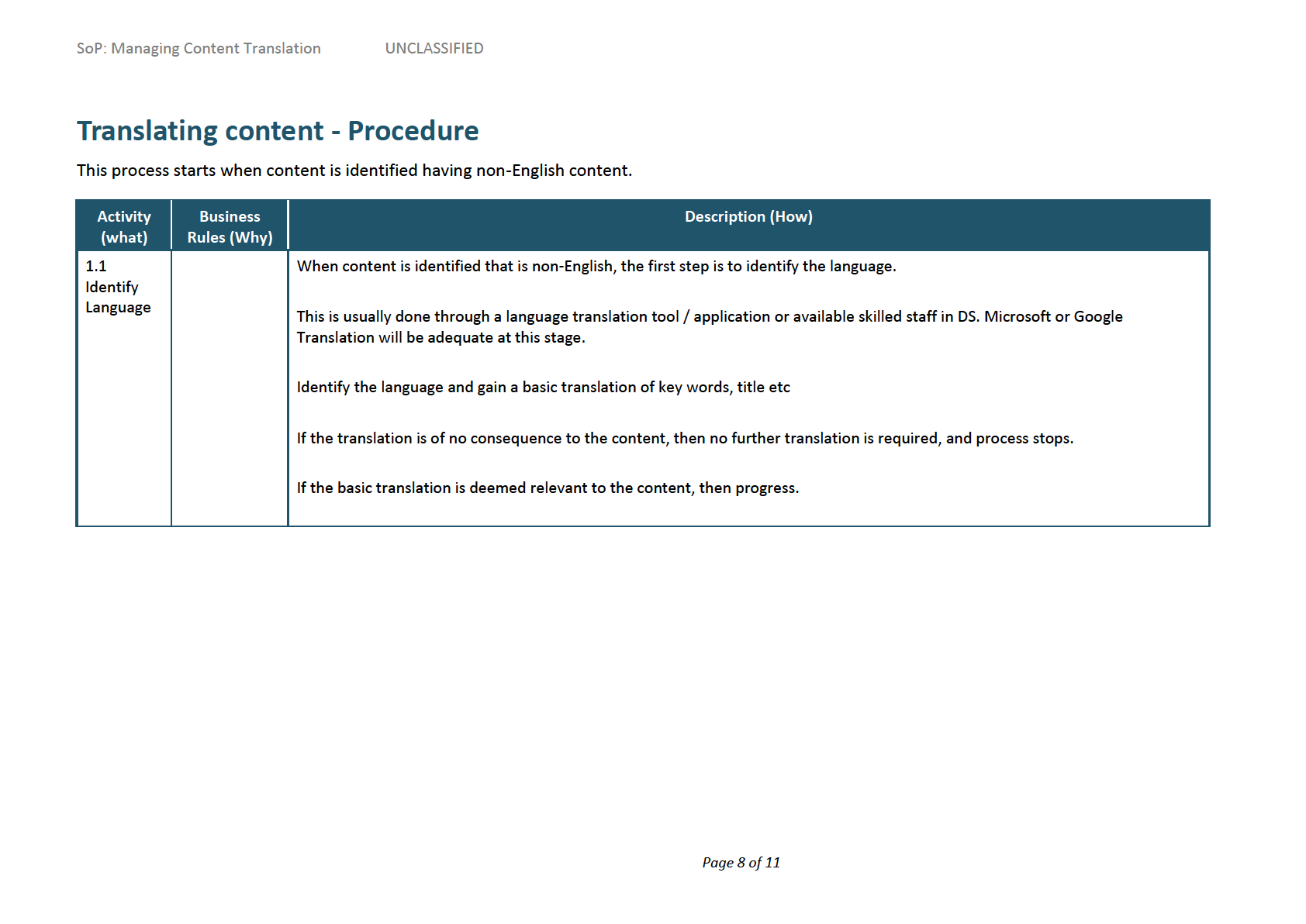
1982
ACT
INFORMATION
OFFICIAL
THE
UNDER
RELEASED
SoP: Managing Content Translation
UNCLASSIFIED
1.2
Confirming
The language and basic translation should be confirmed using a member of the DS team if the language is known within the team,
Confirm
the basic
or using a second translation tool or application in addition to the primary tool / application used.
1982
Basic
translation
Translation will provide
A list of DS staff with language capabilities is found here: https://dia.cohesion.net.nz/ds-staff-language-skills
an indication
ACT
as to
requirements
If using a team member to check a translation, only provide the necessary details and ensure that all risk around the content are
for further
managed.
translation
The basic translation will be added to the case file.
support
If the content is complex (e.g. verbal chanting / singing) and a basic translation is not possible, discuss with Manager and go to the
next step.
INFORMATION
If a formal translation is not required, the process will stop.
The case file will be updated with the decision not to progress with a translation.
1.3 Is a
A formal
If formal translation is required, the content needs to be reviewed to decide what will be sent for translation. A list of TS cleared
formal
translation is
and specialist staff can be used to identify specific translator for request. It can be found here: https://dia.cohesion.net.nz/TS-
OFFICIAL
translation only required
cleared and specialist translators
required?
if the content
is being
THE
referred for
classification
or is required
as evidence
UNDER
RELEASED
Page 9 of 11
SoP: Managing Content Translation
UNCLASSIFIED
2.0
A request for
A template for requesting a formal translation can be found here: Translation Services Request for Support
Request a
translation
1982
translation will need a
Content for translation will need to consider
manager’s
•
sign off as it
what information is required for translation
ACT
will incur a
• summary of context and language
cost
• all necessary information for a translation
• mask any harm where possible, if all the content is required to support the translation. Advise Classification Office if
Only send the
harmful imagery is part of content being sent (complete relevant box in translation request template)
amount of
information
required for
the
INFORMATION
translation
2.1
This will take
Once received, the formal translation will need to be added to the case file, and progressed for whatever purpose the translation
Translation approximately was required (e.g.: classification)
received
3-5 business
days, but can
be expedited
OFFICIAL
as a priority
turn-around
through direct
THE
engagement
with Manager
TS
UNDER
RELEASED
Page 10 of 11
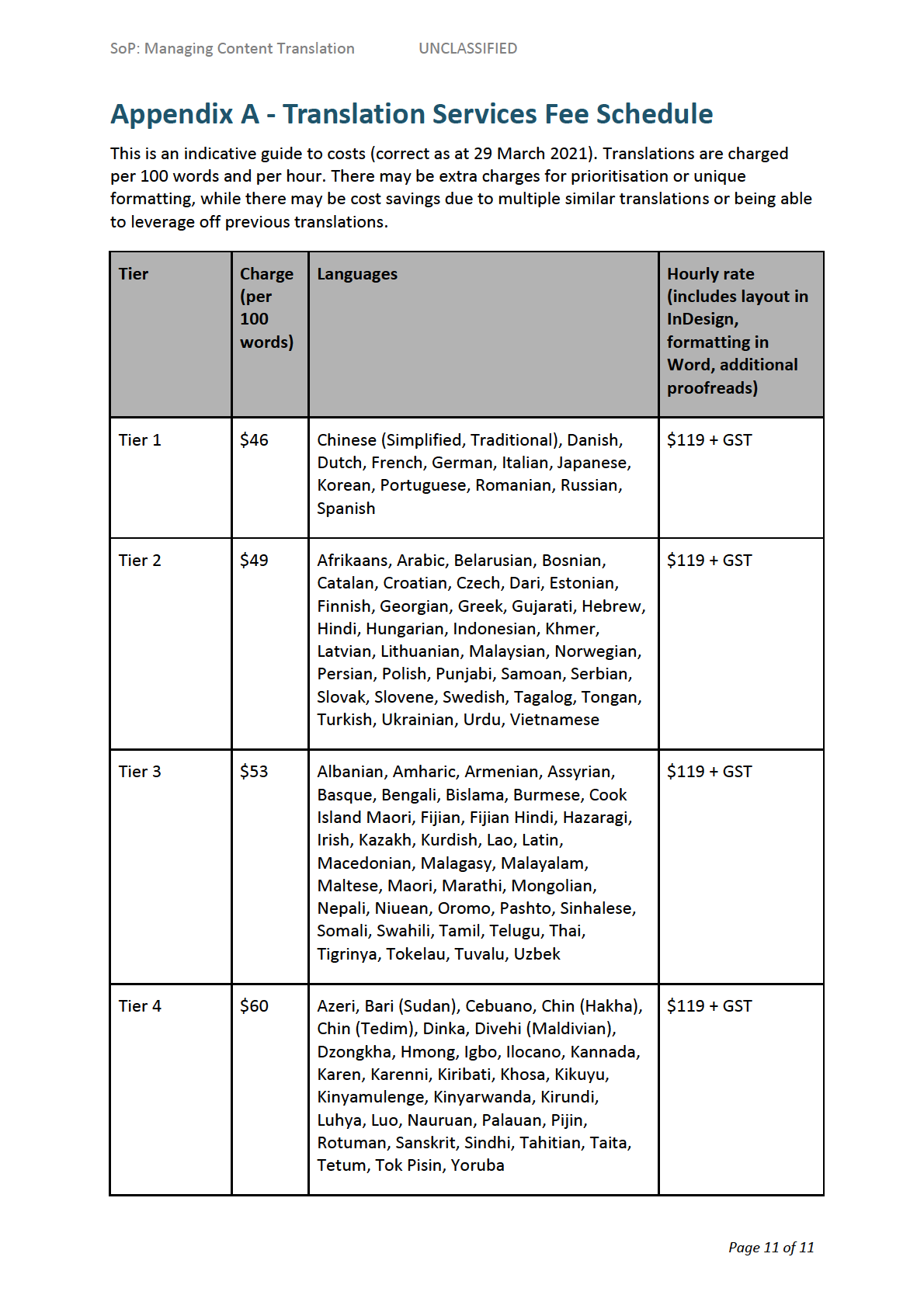
1982
ACT
INFORMATION
OFFICIAL
THE
UNDER
RELEASED

1982
ACT
INFORMATION
OFFICIAL
THE
UNDER
RELEASED
Guide: Legal Services Requests
The request is emailed through to a central email box and is assigned based on the type of
request and capacity. A sample of the type of information needed is include in the sample
request for Legal services attached to this guide.
http://1840.dia.govt.nz/groups/organisational-strategy-and-performance/legal#how2
Legal Advice related to Case Management and Prosecutions
For legal advice related to a case or prosecutions, there are specific lawyers that will work on
DS matters. These are currently:
1982
- Tamsyn Badland for DCE
- Vatau Sagaga for DCE
ACT
- Alice Liddell for DCE
- Vicki Scott (Team Manager) for all prosecutions
All requests for legal work must be sent through the email inbox. This is to enable Legal
Service to manage their caseloads and ensure the must appropriate lawyer is assigned to the
case.
All new requests or legal services needs to be discussed with a manager in the first instance,
INFORMATION
and then sent through to the legal services inbox. Legal will expect that discussions have
taken place and that all/any possible answers and scenarios have been tested.
Case management queries where a lawyer is already involved on the file can be sent directly
to the lawyer. Any query where there is no lawyer assigned then the form can be used and
sent to the inbox.
OFFICIAL
A request for a prosecution review does not usually require a form as it I quite clear what is
THE
sought. What does happen is we would have a heads up from the manager to say there are
files on their way. The request is still sent to the main inbox.
UNDER
RELEASED
Page 2 of 4
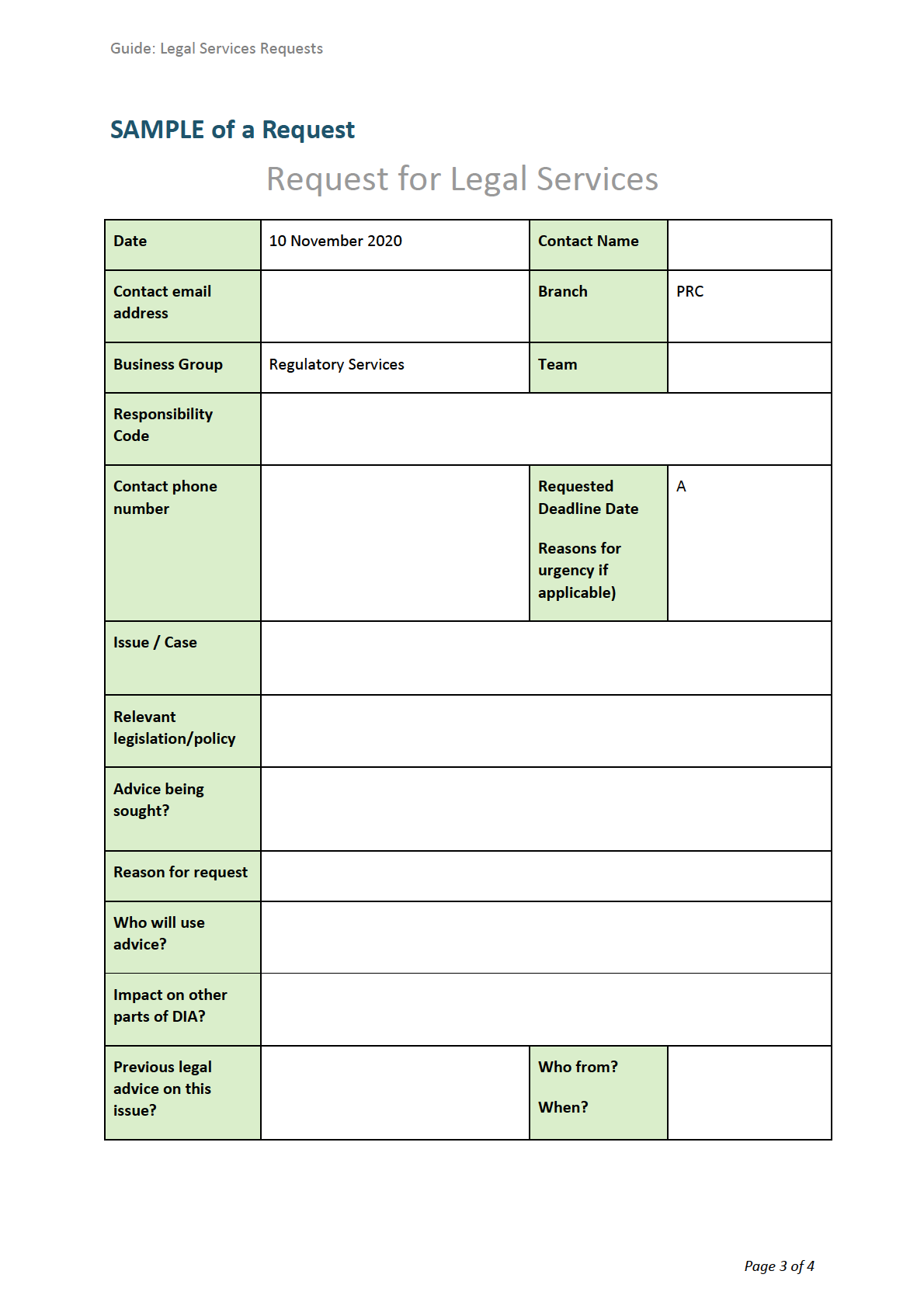
1982
ACT
INFORMATION
OFFICIAL
THE
UNDER
RELEASED
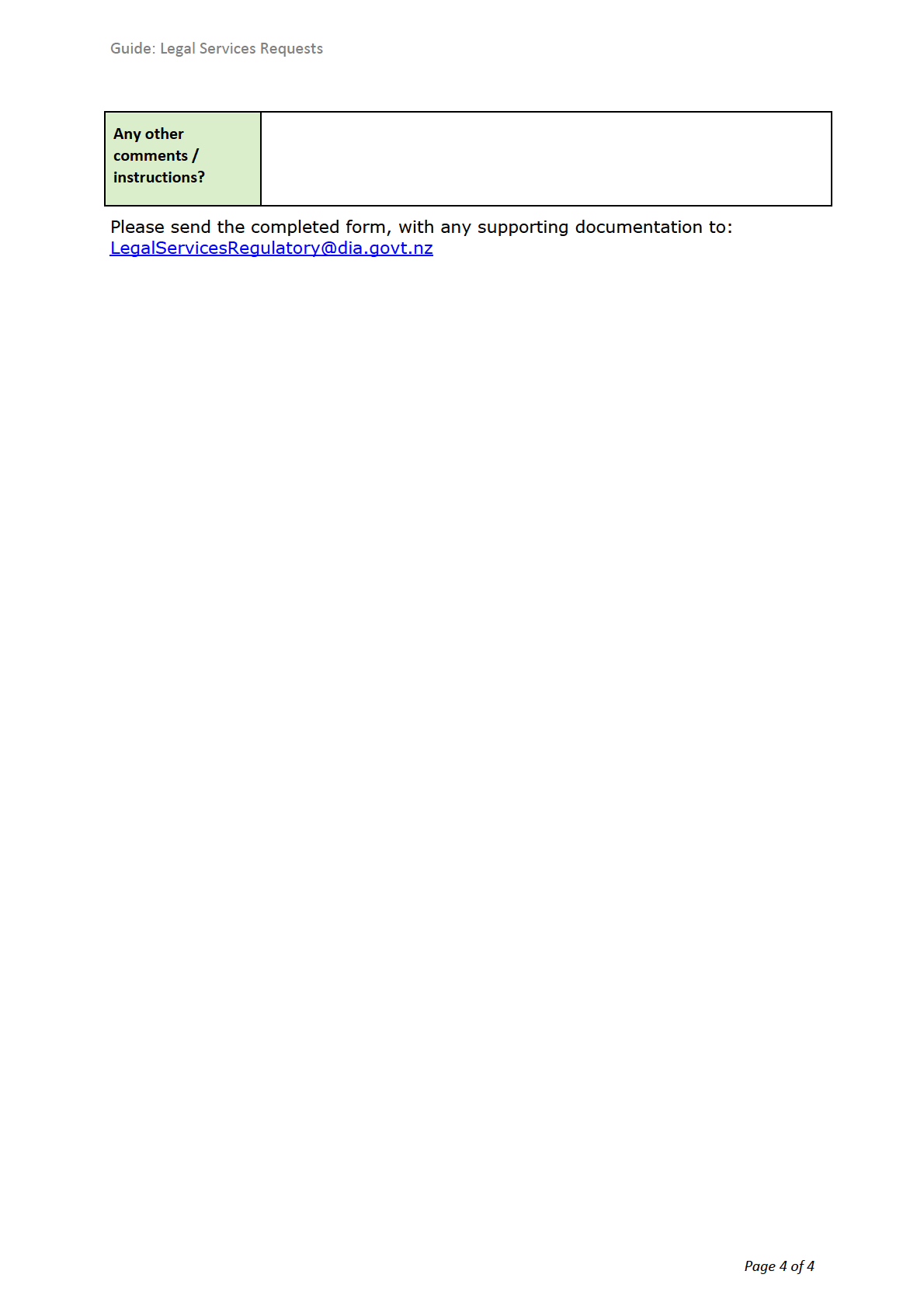
1982
ACT
INFORMATION
OFFICIAL
THE
UNDER
RELEASED













